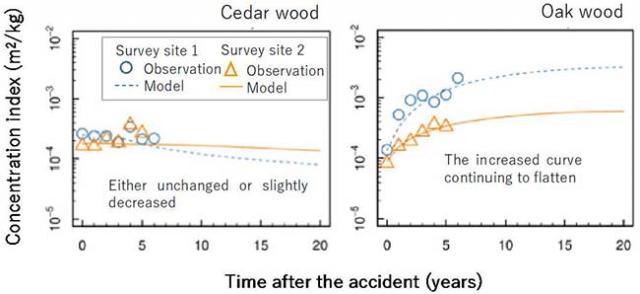Home > Research > Research Results > Research Results 2020 > Predicting the future dynamics of radioactive cesium in forests based on latest observation data and model
Update:March 11, 2020
Main content starts here.
Predicting the future dynamics of radioactive cesium in forests based on latest observation data and model ―Dynamics within forests are nearing equilibrium—
| Article title |
New predictions of 137Cs dynamics in forests after the Fukushima nuclear accident |
|---|---|
| Author (affiliation) |
Shoji Hashimoto (a), (b)*, Naohiro Imamura (a), Shinji Kaneko (c), Masabumi Komatsu (d), Toshiya Matsuura (e), Kazuya Nishina (f), and Shinta Ohashi (g) (a) Department of Forest Soils, FFPRI, Tsukuba, Ibaraki, Japan. (b) The University of Tokyo, Bunkyo-ku, Tokyo, Japan. (c) Kansai Research Center, FFPRI, Kyoto, Japan. (d) Department of Mushroom Science and Forest Microbiology, FFPRI, Tsukuba, Ibaraki, Japan. (e) Department of Forest Management, FFPRI, Tsukuba, Ibaraki, Japan. (f) National Institute for Environmental Studies, Tsukuba, Ibaraki, Japan. (g) Department of Wood Properties and Processing, FFPRI, Tsukuba, Ibaraki, Japan. |
| Publication Journal |
Scientific Reports, 10(1), January 2020 DOI:10.1038/s41598-019-56800-5( External link ) |
| Content introduction |
After the Fukushima Daiichi Nuclear Power Plant accident, radionuclides fell on an area approximately 70% of which was covered with woodlands. In forests, radioactive cesium is distributed in foliage, tree bark, wood, fallen leaf layer on the ground surface, and mineral soil beneath that. However, the distribution of radioactive cesium in forests gradually changes due to dynamics such as migration from trees to the ground surface via defoliation and absorption from roots. It is essential for people involved in forest management to comprehensively understand the dynamics of radioactive cesium in forests based on the combination of data acquired from observation, thereby predicting future dynamics. The Forest Research and Management Organization has been continuously conducting surveys on forest radioactive cesium as part of the “Project for Understanding the Actual Condition of Radionuclides within Forests” promoted by the Forestry Agency. In 2013, we developed a model for simulating the dynamics of radioactive cesium based on 2 years’ worth of observation data. In the present study, we improved this model by using the latest observation data and conducted the following surveys in a cedar single-forest and an oak/pine mixed forest: (1) long-term prediction of intra-forest radioactive cesium distribution; and (2) long-term prediction of radioactive cesium concentrations in cedar/oak wood. Consequently, it was predicted that the accumulation of radioactive cesium in the mineral soil, which had been revealed by observation, would remain unchanged for an extended period in the future. Furthermore, the computer simulation predicted that the radioactive cesium concentrations in cedar wood, whose changes had been observed to be small, would continue exhibiting little to no change (Figure 1 left). In oak wood, the radioactive cesium concentrations had been steadily increasing, and the simulation predicted that this recent trend would continue thereon with the increase becoming more gradual (Figure 1 right). Detailed observation of the prediction model for intra-forest radioactive cesium distribution reveals that radioactive cesium migrated greatly within the forests in the year of the power plant accident; however, the rate of migration quickly subsequently declined. Accompanied by this change, the intra-forest circulation of radioactive cesium decreased, nearing equilibrium (Figure 2). In oak wood, the absorption of radioactive cesium via defoliation exceeded the discharge of radioactive cesium from trees, therefore resulting in the increased concentrations within the wood. In both the cedar single-forest and oak/pine mixed forest, the circulation volume under equilibrium was estimated to be below 1% of the total radioactive cesium quantity entering the forests at the time of the accident. This study provides critical information that not only helps comprehensively understand observation data but also facilitates planning proper management of contaminated forests. In this study, we conducted long-term prediction of how radioactive cesium concentrations would fluctuate within “wood,” an indispensable material for forestry. Based on the previously obtained data, we predicted the long-term distribution of radioactive cesium concentrations from area to area. These findings will be useful in formulating zoning plans for the management of contaminated forests (e.g., which types of forestry operations are realistically feasible in which areas). The half-life of radioactive cesium that entered the forests after the incidents (cesium-137) is approximately 30 years, which is relatively long. Therefore, the management of contaminated forests is a long persistent challenge. In this study, the future intra-forest radioactive cesium concentrations were predicted based on the organically combined data obtained from our continuous observations and model studies. We intend to continue performing highly reliable observations and, at the same time, updating models predicated on the latest data. We also believe that it is essential to perform predictions using various models in order to improve precision and accuracy further.
Figure 1. Predicted concentrations of cesium-137 in cedar (left) and oak (right) wood. The concentration index (term description 2) was the cesium-137 concentration in the wood that was normalized by dividing by the total deposition immediately after the accident. In the cedar wood, the concentrations remained unchanged or slightly decreased. In the oak wood, the increased curve was predicted to continue becoming gradual.
Figure 2. Prediction of cesium-137 circulation in the cedar single-forest (left) and the oak/pine mixed forest (right). The discharge from trees via defoliation etc., (continuous line) and the predicted absorption from tree roots (dotted line) were used to quantify the circulation. Both were balanced 5–10 years after the incidents. However, based on this model, the absorption from tree roots was predicted to exceed the discharge only in the oak trees in the oak/pine mixed forest. This contributed to the increased concentration in the oak wood in this model prediction. |
Copyright © Forest Research and Management Organization. All rights reserved.


